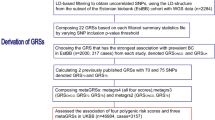Abstract
A genetic epidemiologic analysis of gastric cancer in the Chinese Han population was conducted for 64 pedigrees (902 individuals) with gastric cancer and controls obtained from the population after a census was carried out in August 2007. The heritability of gastric cancer was performed using the Falconer method and the complex segregation analysis was performed using the Statistical Analysis for Genetic Epidemiology (S.A.G.E.) SEGREG program. The heritability of gastric cancer in first- and second-degree relatives was 54.75% (95% CI, 48.01–61.49%) and 44.97% (95% CI, 33.12–56.82%), respectively. The estimated segregation ratio of gastric cancer was 0.039 (95% CI, 0.017–0.061). The complex segregation analysis showed that the Mendelian inheritance of additive model provided the best fit to the data (AIC = 170.58, P > 0.05). Therefore, polygenetic or multi-factorial additive inheritance is involved in the genetic predisposition for the development of gastric cancer.
Similar content being viewed by others
Abbreviations
- S.A.G.E:
-
Statistical analysis for genetic epidemiology
- OR:
-
Odds ratio
- 95%CI:
-
95% confidence intervals
- SD:
-
Standard deviation
- H. pylori:
-
Helicobacter pylori
- h 2 :
-
Heritability
- P LM :
-
Segregation ratio
- LnL:
-
Natural log likelihood
- AIC:
-
Akaike’s information criterion
References
Sun XB, Hu ML, Quan PL (2006) An analysis of mortality trend with stomach cancer in henan, 1984–2003. Bull Chin Cancer 15:291–293
Foschi R, Lucenteforte E, Bosetti C et al (2008) Family history of cancer and stomach cancer risk. Int J Cancer 123:1429–1432
Nguyen TV, Janssen MJ, van Oijen MG et al (2010) Genetic polymorphisms in GSTA1, GSTP1, GSTT1, and GSTM1 and gastric cancer risk in a Vietnamese population. Oncol Res 18(7):349–355
Zhou XF, He YL, Song W et al (2009) Comparison of patients by family history with gastric and non-gastric cancer. World J Gastroenterol 21:264450
Kanamori M, Schnell AH, Inoue M et al (2001) Segregation analysis of gastric cancer in a Japanese population. Int J Human Genetic 1:263–270
SAGE (1994). Statistical analysis for genetic epidemiology. Rel. 2.2. Computer program package available from the Department of Epidemiology and Biostatistics, Case Western Reserve University, Cleveland, OH
Tarone RE (1979) Testing the goodness of fit of the binomial distribution. Biometrika 66:585–590
Falconer DS (1981) Introduction to quantitative genetics, 2nd edn. Longman Press, New York
Li CC, Mantel N (1968) A simple method of estimating the segregation ratio under complete ascertainment. Am J Hum Genet 20:61–81
Bonney GE, Elston RC, Correa P, Tannenbaum SR et al (1987) Genetic etiology of gastric carcinoma: II. Segregation analysis of gastric pH, nitrate, and nitrite. Genet Epidemiol 4:103–114
Akaike H (1974) A new looks at the statistical model identification. IEEE Trans Automat Contr 19:716–723
Kondo T, Toyoshima H, Tsuzuki Y et al (2003) Aggregation of stomach cancer history in parents and offspring in comparison with other sites. Int J Epidemiol 32:579–583
Olopade OI, Pichert G (2001) Cancer genetics in oncology practice. Ann Onc 12:895–908
Milne AN, Sitarz R, Carvalho R et al (2007) Early onset gastric cancer: on the road to unraveling gastric carcinogenesis. Curr Mol Med 7:15–28
Eto K, Ohyama S, Yamaguchi T, Wada T et al (2006) Familial clustering in subgroups of gastric cancer stratified by histology, age group and location. Eur J Surg Oncol 32:743–748
Hemminki K, Sundquist J, Ji J (2007) Familial risk for gastric carcinoma: an updated study from Sweden. Br J Cancer 96:1272–1277
Milne AN, Carvalho R, Morsink FM et al (2006) Early-onset gastric cancers have a different molecular expression profile than conventional gastric cancers. Mod Pathol 19:564–572
Emery AEH (1986) Methodology in medical genetics. Churchill Livingston Press, London
Lee JH, Barral S, Cheng R et al (2008) Age-at-onset linkage analysis in caribbean hispanics with familial late-onset Alzheimer’s disease. Neurogenetics 9(1):51–60
Dong LM, Potter JD, White E et al (2008) Genetic susceptibility to cancer: the role of polymorphisms in candidate genes. JAMA 299:2423–2436
Schneider BG, Camargo MC, Ryckman KK et al (2008) Cytokine polymorphisms and gastric cancer risk: an evolving view. Cancer Biol Ther 7:157–162
Acknowledgments
This work was supported by grants from National Natural Science Foundation of China [No.30972547]. Some results of this paper were obtained by using the program package S.A.G.E. We thank all the families for their participation in the study; thank the staff of Xin’an County Centers for Disease Control and Prevention (CDC), Henan Province, to support our epidemiological study on the scene.
Author information
Authors and Affiliations
Corresponding author
Appendix
Appendix
The formulae of segregation ratio (P LM ) estimation:
Here, P LM stands for the segregation ratio, R stands for the total number of affected individuals, J stands for the total number of families with only one affected offspring, and T stands for the total number of affected and unaffected offspring.
Rights and permissions
About this article
Cite this article
Gao, S., Zhang, X., Wang, P. et al. Genetic epidemiological analysis reveals a multi-gene additive model for gastric cancer. Familial Cancer 10, 119–125 (2011). https://doi.org/10.1007/s10689-010-9391-0
Published:
Issue Date:
DOI: https://doi.org/10.1007/s10689-010-9391-0




